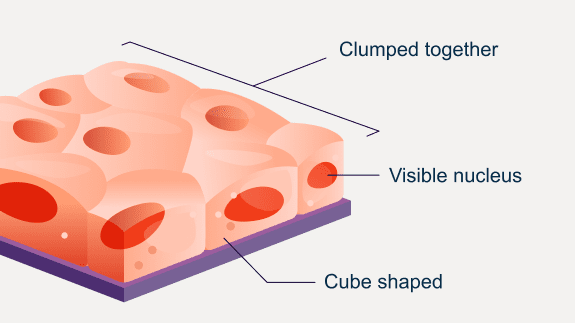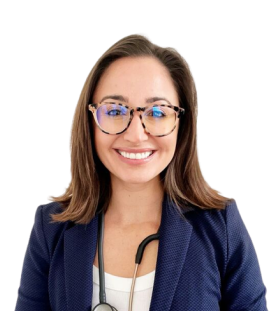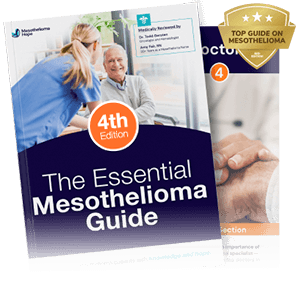What Is Epithelioid Mesothelioma?
Epithelioid mesothelioma is one of the three cell types of malignant mesothelioma. The other cell types are sarcomatoid and biphasic.
More than half of patients diagnosed with mesothelioma have the epithelioid cell type, according to the American Cancer Society (ACS).
Specially trained doctors called pathologists can identify epithelial cells based on how they look under a microscope.

Epithelioid cells are known for their:
- Clearly visible nucleus
- Slower movement
- Square, long, or flat shape
- Tendency to stick together
Epithelioid patients generally have a better prognosis than patients with sarcomatoid or biphasic mesothelioma cell types. This is because epithelioid tumors spread (metastasize) slower and are more responsive to treatments.
Get our Free Mesothelioma Guide for details on cell types, treatment options, and other essential information you need to navigate this cancer.
What Causes Epithelioid Mesothelioma Cancer?
Malignant epithelioid mesothelioma, like all other types of mesothelioma, is caused by asbestos exposure.
Asbestos can release microscopic fibers into the air when products containing it are disturbed or damaged. If the fibers are breathed in or swallowed, they can become lodged in the lining of the lungs or abdomen and cause scarring and inflammation.
After decades of irritation, genetic changes can cause the healthy epithelial cells that line the inside of the organs to mutate and form epithelioid mesothelioma tumors.
Epithelioid mesothelioma is the most common of three mesothelioma cell types, and it's also the easiest to treat since it doesn't spread as quickly. View Transcript.
Duration: 1 min 27 sec
Mesothelioma, a form of cancer that can develop in the lining of the lungs heart or abdomen has different cell types. Today we’ll shed some light on epithelioid mesothelioma, the most common cell type, about 70% of mesothelioma patients have the epithelioid or epithelial cell type. These patients have a distinct advantage when it comes to treatment options. Epithelial cells tend to grow relatively slowly allowing for more effective treatment strategies such as surgery, chemotherapy, and radiation. Thanks to this slower growth pattern, patients diagnosed with epithelioid mesothelioma have a better prognosis and higher survival rates compared to the other two cell types which are sarcomatoid and basic. If you or a loved one has been diagnosed with mesothelioma, it’s crucial to consult with a doctor who specializes in this rare cancer. They can provide you with the most up-to-date information on treatment options and guide you through your journey toward better health. Remember, early detection and Ely intervention are key to improving outcomes for mesothelioma patients. Stay informed, seek support, and explore all available resources to ensure the best possible care and support for yourself or your loved one. Remember, you are not alone in this fight. Help is just to call away. Contact us today to be connected with a patient advocate who can recommend doctors and treatments for epithelioid mesothelioma.
Because asbestos was used in the U.S. military and various industries for most of the 20th century, many of the people diagnosed with mesothelioma today are retired veterans and blue-collar workers.
“Asbestos was a critical material for World War II. It was used in insulation on the ships. It was used in gaskets, brake linings. That’s when my dad first started working, and that’s when he was first exposed.”
– Patricia, daughter of a veteran diagnosed with mesothelioma
Malignant Epithelial Mesothelioma Symptoms
The symptoms of epithelioid mesothelioma will appear differently depending on where the cancer develops.
Patients whose cancer forms in the lung lining (pleural mesothelioma) will have different symptoms than those with cancer in the abdominal lining (peritoneal mesothelioma).
The chart below shows the common signs and symptoms of each type of epithelioid mesothelioma.
| Symptoms of Pleural Epithelioid Mesothelioma | Symptoms of Peritoneal Epithelioid Mesothelioma |
|---|---|
| Chest pain Fatigue Fluid buildup in the chest (pleural effusion) Shortness of breath Worsening cough | Abdominal pain Constipation or diarrhea Fluid buildup in the abdomen (peritoneal ascites) Night sweats Unexplainable weight loss |
These symptoms usually get worse as the cancer spreads. This is why it’s critical to see a specialist as soon as you start feeling unwell so you can get properly diagnosed and treated. Contact our Patient Advocates so we can help you find a doctor in your area.
Getting an Epithelioid Mesothelioma Diagnosis
Your doctor will use a series of imaging scans and tests to confirm an epithelioid mesothelioma diagnosis. Learn more about the mesothelioma diagnosis process below.
1. Physical Examination
Because the symptoms of epithelial mesothelioma are often vague, they can be mistaken for bronchitis, pneumonia, or digestive issues. A physical examination can help your doctor rule out these more common conditions.
The doctor will start by getting your medical history and checking your vital signs. They will check your breathing with a stethoscope and listen for sounds of fluid buildup, which is one of the early warning signs of pleural mesothelioma (the most common type of this cancer).
They may also feel your chest and abdominal area for any lumps or masses.
2. Imaging Scans
If the doctor sees or hears anything unusual during your physical exam, they can use imaging scans to look for tumors, nodules, scar tissue, and other signs of cancer in your lungs or abdomen.
These scans may include:
- Computed tomography (CT) scans
- Magnetic resonance imaging (MRI) scans
- Positron emission tomography (PET) scans
- X-rays
Imaging tests are a key part of a mesothelioma diagnosis since they can reveal abnormalities your doctor wouldn’t be able to see in a physical exam.
3. Blood Tests for Biomarkers
Some mesothelioma doctors may order blood tests as part of an epithelioid mesothelioma diagnosis. Certain blood tests can show biomarkers (indicators) associated with asbestos exposure, the only known cause of this cancer.
For example, the American Society of Clinical Oncology (ASCO) recommends that doctors order a specific biomarker test known as immunohistochemistry staining. This allows doctors to look for certain proteins, such as calretinin, that can be signs of mesothelioma cancer.
4. Fluid or Tissue Biopsy
If your doctor finds signs of cancer in imaging and blood tests, they will order a biopsy. A biopsy is the only way to confirm an epithelial mesothelioma diagnosis.
After numbing the area with an anesthetic, your doctor will collect a small fluid or tissue sample through a tiny needle. You may feel some pressure during the procedure, which is normal.
A pathologist will then examine the sample under a microscope to see if and what type of mesothelioma cells are present.
Find specialists in your area who can accurately diagnose epithelial mesothelioma with our Free Doctor Match.
Subtypes of Epithelial Mesothelioma Cells
There are several subtypes of epithelioid mesothelioma that can be harder to treat. Most of these cell subtypes are rare and affect a very small number of patients.
Epithelial mesothelioma subtypes include:
- Adenomatoid mesothelioma: This subtype makes up roughly 6% of epithelioid pleural mesothelioma cases.
- Cystic mesothelioma: The cystic cell subtype is typically benign (not cancerous) and found in women with peritoneal mesothelioma.
- Deciduoid mesothelioma: This cell subtype is diagnosed in 5% of mesothelioma patients.
- Lymphohistiocytoid mesothelioma: Only a few lymphohistiocytoid mesothelioma cases have ever been reported (less than 1%).
- Small-cell mesothelioma: This extremely rare subtype is often mistaken for other small-cell cancers.
- Solid mesothelioma: This subtype forms in patterns that look like sheets or nests and has an average prognosis of just over 1 year.
- Tubulopapillary mesothelioma: Patients with these cube-shaped cells have an average prognosis of almost 2 years.
- Well-differentiated papillary mesothelioma: These cells are more common in women than men and do not spread quickly.
Your doctor can tell whether you have one of these epithelial subtypes when reviewing your biopsy results and customize your treatment plan accordingly.


“When it comes to mesothelioma, the epithelioid type tends to have a better outlook than other cell types. That means there’s more reason to stay positive and hopeful about treatment possibilities.”
Epithelioid Mesothelioma Life Expectancy & Prognosis
Epithelioid mesothelioma patients have an average life expectancy of nearly 2 years with surgery.
The table below shows the median survival time in months compared to the other two mesothelioma cell types.
| Mesothelioma Cell Type | Median Survival With Surgery |
|---|---|
| Epithelioid | 22.2 months |
| Sarcomatoid | 12.4 months |
| Biphasic | 6.4 months |
Patients who receive surgery after radiation therapy have an average prognosis of 36 months, according to a study published in Communications Biology.
What Is the Epithelial Mesothelioma Survival Rate?
Mesothelioma doctors use survival rates to track the percentage of patients who are still alive a certain number of years after being diagnosed.
According to a 2022 review of the National Cancer Database, 45% of epithelial mesothelioma patients who have surgery are alive at 2 years, and 14% of patients are still alive at 5 years.
Factors such as your age, cancer stage, and type of mesothelioma will impact your treatment plan.
A prognosis is just an estimate, and every patient will have a different outcome. There is always hope for a longer, healthier life regardless of your initial prognosis.
Get our Free Mesothelioma Guide shipped overnight to learn more about improving your prognosis and life expectancy.
Options for Epithelial Mesothelioma Treatment
Epithelial cells are the easiest of all three mesothelioma cell types to treat. Learn more about the different types of mesothelioma treatments for this cancer below.
Surgery
Tumor-removing surgery is the most effective way to treat mesothelioma. Patients who have the epithelioid type are more likely to qualify for mesothelioma surgery than those with sarcomatoid or biphasic cells.
The three most common mesothelioma surgeries are:
- Cytoreduction with heated chemotherapy for peritoneal mesothelioma
- Extrapleural pneumonectomy (EPP) for pleural mesothelioma
- Pleurectomy with decortication (P/D) for pleural mesothelioma
In a study of 355 malignant pleural mesothelioma patients, P/D surgery was more effective than EPP surgery for the epithelioid cell type. Patients who got a P/D had an overall survival time of over 2.5 years, compared to 1.5 years with an EPP.
Chemotherapy
Chemotherapy works by administering cancer-fighting drugs to stop epithelial mesothelioma cells from spreading.
Common chemotherapy drugs for mesothelioma include:
- Carboplatin
- Cisplatin
- Gemcitabine
- Pemetrexed
Most patients receive multiple rounds of mesothelioma chemotherapy with a few weeks off between treatments so they can recover.
Immunotherapy
Mesothelioma immunotherapy is a type of treatment that helps the body’s immune system better recognize and attack cancer cells.
Two immunotherapy drugs have been approved to treat epithelioid pleural mesothelioma: nivolumab (Opdivo®) and ipilimumab (Yervoy®).
Other immunotherapy drugs are being tested in clinical trials to see if they can help pleural and peritoneal epithelioid mesothelioma patients live longer.
According to a case study published in Cureus Journal of Medical Science, the immunotherapy drug pembrolizumab (Keytruda®) combined with chemotherapy helped a male patient achieve complete remission from epithelioid peritoneal mesothelioma.
This means all signs and symptoms of his cancer disappeared. As of 2024, he’s still in remission more than 4 years later.
Radiation Therapy
Radiation therapy for mesothelioma is a treatment that uses high-energy rays to target and kill cancer cells by damaging their DNA.
This treatment is often used to shrink epithelioid mesothelioma tumors before surgery or to help reduce symptoms when surgery isn’t possible.
Use our Free Questions to Ask Your Doctor Checklist to get the answers you need about radiation therapy and other epithelioid mesothelioma treatments.
Emerging Treatments in Clinical Trials
Along with the standard cancer treatments covered above, epithelial mesothelioma patients may be able to access new and emerging treatments by enrolling in clinical trials.
Examples of emerging treatments being researched include:
- Epigenetic therapy, which aims to reactivate tumor suppressor genes to halt or reverse cancer progression
- Gene therapy, which involves inserting genes into mesothelioma cells to make them more susceptible to cancer-fighting drugs
- Mesothelioma vaccines, which inject antigens that are found on mesothelioma cells to help the immune system recognize and destroy them more effectively
- Targeted therapy, which uses drugs or other substances to precisely identify and attack cancer cells without damaging normal cells
For example, results from a recent study found that AXL and ATR inhibitors — a type of targeted therapy — could be effective in preventing epithelioid tumors from growing and spreading.
Your mesothelioma doctor can see if you qualify for clinical trials in your area. Our Patient Advocates can help you find a doctor to get started — learn more below.
Find Epithelioid Mesothelioma Treatment Near You
Facing an epithelioid mesothelioma diagnosis can be overwhelming, but having the right medical team by your side is crucial for your journey toward treatment and recovery.
At Mesothelioma Hope, we can help make the process of starting treatment as easy and stress-free as possible.
Our dedicated team is here to guide you every step of the way, from connecting you with the right specialist to preparing you for your first appointment.
Call us today at (866) 608-8933 or try our Free Doctor Match to get started.
Epithelial Mesothelioma FAQs
What is the prognosis for epithelioid mesothelioma?
Epithelioid mesothelioma has an average prognosis of almost 2 years with surgery, but many patients live longer than this with multimodal treatment.
Mesothelioma multimodal therapy involves using a combination of two or more treatments to fight different aspects of this cancer.
Patients with epithelioid pleural mesothelioma who received Surgery for Mesothelioma After Radiation Therapy (SMART) have an average prognosis of 36 months.
What causes epithelioid mesothelioma?
Epithelioid mesothelioma, like other cell types of this cancer, is caused by exposure to asbestos fibers.
It takes roughly 10-50 years for epithelioid mesothelioma to form after asbestos exposure. People can be exposed in various workplaces where asbestos is mined, processed, or used to make various products, such as construction sites, shipyards, and factories.
Additionally, secondary exposure can occur when spouses or children come into contact with asbestos fibers carried home on the clothing of family members who work with asbestos-containing products.
Is epithelioid mesothelioma curable?
There isn’t a cure for epithelioid mesothelioma yet, but since this cell type is the most responsive to treatment, there’s hope that it may be curable in the future.
In the meantime, treatment options such as surgery, chemotherapy, and immunotherapy can be used to manage the disease, relieve symptoms, and improve quality of life.
What is the survival rate for epithelioid mesothelioma?
The epithelioid mesothelioma survival rate is the percentage of mesothelioma patients who are still alive at a certain time after diagnosis.
The 2-year and 5-year survival rates for pleural epithelioid mesothelioma patients treated with surgery, chemotherapy, and radiation are as follows:
- 65% of patients are still alive at 2 years
- 27% of patients are still alive at 5 years
Individual factors like age, cancer stage, and overall health can affect your survival time, so it’s important to see a mesothelioma specialist for personalized treatment.
What are the stages of epithelioid mesothelioma?
There are four epithelioid mesothelioma stages for patients diagnosed with pleural mesothelioma. Mesothelioma stages are used to describe if and how far the cancer has spread through the body, and it has a direct effect on your treatment plan.
In the early stages (stages 1 and 2), the cancer is mostly contained to the lung lining (pleura) and is easier to treat with surgery and chemotherapy.
By the time the cancer has advanced to stages 3 and 4, tumors may have spread to distant areas of the body and may not be able to be removed with surgery. In these cases, chemotherapy and immunotherapy may be options to help manage symptoms, slow cancer spread, and improve quality of life.







